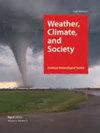On the risk efficiency of a weather index insurance product for the Brazilian semi-arid region
IF 1.9
4区 地球科学
Q3 ENVIRONMENTAL STUDIES
引用次数: 0
Abstract
Abstract Weather index insurance (WII) has long been advertised as a viable alternative to crop yield insurance. WII products were firstly developed to assist climate-vulnerable farmers from developing countries where establishing a well-structured crop insurance market is expressively difficult due to the poor transport infrastructure and the prevalence of sparsely distributed small-scale farms. In Brazil, the semi-arid region stands out as the one that concentrates the ideal conditions for the implementation of a WII product since it houses thousands of climate-vulnerable farmers. With this in mind, we designed and priced a WII product for farmers from the semi-arid region of Brazil and posteriorly investigated its risk efficiency. To do so, we first investigated crop yield responses to aridity, enabling the selection of locations for which the WII product was posteriorly assessed. Second, we grouped selected locations into specific contracts according to geographical proximity and evaluated each of these contracts to attest the risk efficiency of the proposed WII product using the method of stochastic efficiency with respect to a function (SERF), which identifies utility efficient alternatives for a range of risk attitudes. Our results show that the WII product may be effective in protecting farmers from adverse variations in production revenue, possibly being attractive for utility-maximizer farmers that are sufficiently risk-averse.巴西半干旱地区天气指数保险产品的风险效率研究
天气指数保险(WII)长期以来一直被宣传为农作物产量保险的可行替代方案。WII产品最初是为了帮助发展中国家易受气候影响的农民而开发的,在这些国家,由于交通基础设施落后和小规模农场分布稀疏,建立结构良好的作物保险市场非常困难。在巴西,半干旱地区因集中了实施WII产品的理想条件而脱颖而出,因为那里居住着数千名易受气候影响的农民。考虑到这一点,我们为巴西半干旱地区的农民设计并定价了WII产品,并对其风险效率进行了后续调查。为此,我们首先调查了作物产量对干旱的反应,从而选择了对WII产品进行事后评估的地点。其次,我们根据地理位置将选定的地点分组为特定的合同,并对每个合同进行评估,以证明所提议的WII产品的风险效率,使用相对于函数(SERF)的随机效率方法,该方法确定了一系列风险态度的效用效率替代方案。我们的研究结果表明,WII产品可能有效地保护农民免受生产收入不利变化的影响,可能对效用最大化的农民具有吸引力,这些农民足够厌恶风险。
本文章由计算机程序翻译,如有差异,请以英文原文为准。
求助全文
约1分钟内获得全文
求助全文
来源期刊

Weather Climate and Society
METEOROLOGY & ATMOSPHERIC SCIENCES-
CiteScore
3.40
自引率
13.60%
发文量
95
审稿时长
>12 weeks
期刊介绍:
Weather, Climate, and Society (WCAS) publishes research that encompasses economics, policy analysis, political science, history, and institutional, social, and behavioral scholarship relating to weather and climate, including climate change. Contributions must include original social science research, evidence-based analysis, and relevance to the interactions of weather and climate with society.
 求助内容:
求助内容: 应助结果提醒方式:
应助结果提醒方式:


